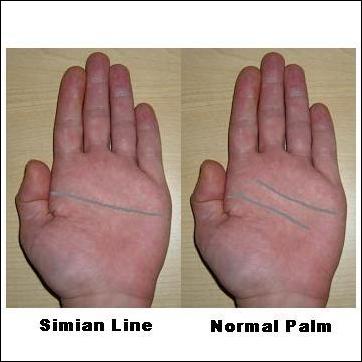The cause of Down's syndrome:
Well, the story starts like that: There happens an error in cell division which is called nondisjunction. Here the chromosome 21 of the human genome doesn't divide properly and this results in an additional chromosome 21 in the genome of an embryo.
There are three types of trisomy 21, where either a whole extra chromosome is placed into a sperm or eggcell, which results in 3 chromosomes of the same kind. We call this
complete trisomy 21.
Another case is
mosaic trisomy 21, where there was a correct number of chromosomes when sperm and egg united but shortly afterwards disjunction happened so that part of the cells carry an extra chromosome 21. The third case would be
translocation trisomy 21, where just a section of the chromosome is added to a full set of chromosomes and is by cell division copied into the other cells.
The symptomes:
There are two kinds of impairment to notice for Down's syndrome:

Physically, there are multiple things, which can cause difficulties for people with Down's syndrome. These include a poor muscle tone, short necks, excess skin on the neck, a flattened facial profile, small ears, eyes and mouth, upward slanting eyes, white spots in coloured parts of the eye. Additionally they have wide hands, which are short and short fingered, and which also include a deep crease across the palm. About there toes there is to notice a deep groove between first and second toe.
Also mentally there are some impairments in spite of the impairment of movement, which also exists. They have most times a slowliness in thinking and learning and general cognitive processes. Also, they have poor concentration and judgement and can have strong impulses. Nevertheless they can in their mental ability reach a potential good level and don't necessarily have to be much disadvantaged to healthy people.
Other impacts of Down's syndrome:
People with this disease today have a life expectancy of around 60 years, which is a great improvement to 1983, where it was much lower with 25 years.
One complication of Down's syndorme is also that they are more infertile with around 30-50 % of women who can reproduce and nearly no men, whereby it is unsure if men lack in sperm development or are just uninterested in sexual activity. But half of the children who have are produced by people with Down'ssydrome inherite the disease, when not using assisting technologies.
Ethical issues:
 |
Mother with Downs Syndrome, Father with slight mental handicap,
completely normal baby, one incredibly happy family. |
The most important fact of people who have the syndrome is that we don't disadvantage these people and that we respect them and treat them with care and charitableness. One ethical issue which I see in the whole issue is weither it should be allowed for them to reproduce, because they will have a high chance to give birth to another human with the syndrome. Here the question is if it is good for the child itself to have such social disadvantages when it lives in our societies and that there has probably to be money provided from the state, which is eventually the money of our health insurance bill payed. In addition there is the question if the Down's syndrome suffering parents are responsible enough to bring the child up properly. But all in all I think that because the Down's syndrome sufferers ae humans and have therefore the right to act on their own and have freedom of action, they should probably be allowed to decide to have chidren, also I disapprove of the decision itself.
https://en.wikipedia.org/wiki/Down_syndrome#Fertility
http://www.ndss.org/Down-Syndrome/Down-Syndrome-Facts/
http://www.ndss.org/Down-Syndrome/Down-Syndrome-Facts/
https://www.nichd.nih.gov/health/topics/down/conditioninfo/Pages/causes.aspx




